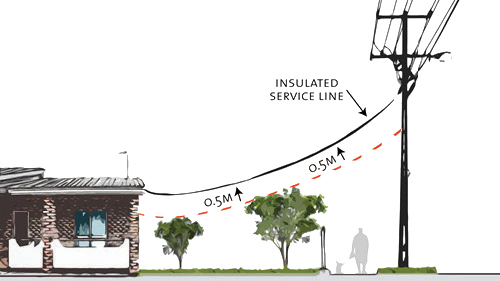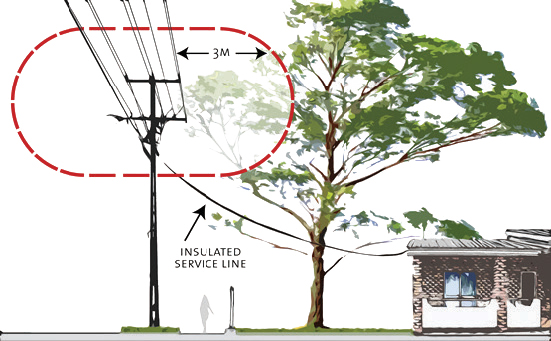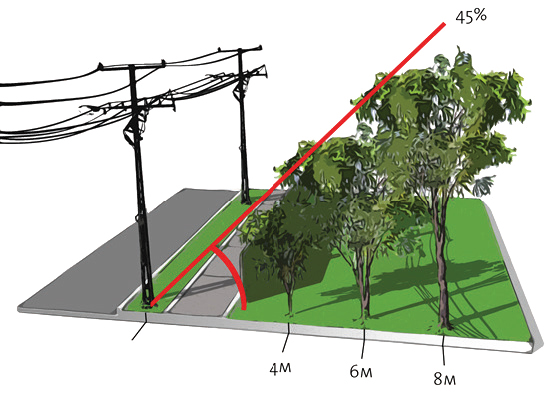Safety around trees and powerlines
Tropical Cyclone Fina
If you remain without power, it’s important that you let us know.
Safety around trees and powerlines
Trees, palm fronds and branches can be touching or blown into powerlines can cause outages, conduct electricity and be a safety hazard.
Call us about trees near powerlines
Your safety is our main concern, so if you see a tree or palm within three metres of a power line, please call us before starting any pruning or tree removal. There may be safety issues to consider. You can also log a query or fault online or on our app. Download the app from the Contact Us page.
If our contractor notifies you that a work crew will be in your area and you wish to discuss vegetation around power lines, email customerservice@powerwater.com.au or call us on 1800 245 092.
Wildlife and power infrastructure
Wildlife can adversely affect our power network by nesting and sheltering in and near infrastructure.
We do our best to keep animals out but they will still find their way into some precarious spots. When they do, we do our best to rescue them safely.
Bats, or flying foxes, are a seasonal cause of power interruptions across Australia. They move around as their food sources change, so it is hard to take targeted defensive action.
In the rural area, we have upgraded insulators on overhead powerlines and installed specially-designed mesh mats and animal covers along the Humpty Doo, Dundee and Bynoe feeders.
We also prune back trees near power lines to keep wildlife at a distance.
Report wildlife problems to us on 1800 245 090.
If you have been experiencing poor power supply reliability, you may be eligible for a credit on your electricity account.
We will automatically apply this through your retailer under the Guaranteed Service Levels (GSL) set out in the Electricity Industry Performance Code and Guidelines .
Roadside overhead power lines
Our contractors will clear vegetation around roadside power lines and remove debris. This includes debris from trees on if its affecting power lines.
Sometimes debris from trees outside your yard might fall into your yard. The tree trimming contractor will leave a card for you to contact us to arrange a suitable time to enter your yard and remove the debris.
We work closely with local councils and the Department of Infrastructure, Planning and Logistics to manage vegetation around roadside power lines.
Do unsafe trees have to be totally removed?
Some trees and palms are not suitable for growing under or near powerlines. If this is the case, pruning is not enough and may need to be removed.
If contractors identify unsafe vegetation on private property, the property owner will be contacted to discuss removal.
Occasionally, a tree or palm in front of your property may need to be removed. This is done in consultation with your local
council.
How can you help?
Call us if you see a tree or palm close to or touching a powerline. Don't try to prune it yourself, as this is dangerous.
If you are landscaping near or under powerlines, plan ahead. See below the right type of trees and shrubs to plant near power lines and the required distance for planting.
Who cuts the trees?
Safety is our main concern so we contract specially trained arborists to identify and remove trees near powerlines.
They follow the Australian Standard AS4373 ‘Pruning of Amenity Trees’ .
Electricity service line on your property
Property owners are responsible for keeping trees clear of the insulated service line, which is the line running from the power pole on the road to a property.
Before trimming trees near powerlines, call 1800 245 092 or a qualified arborist for advice.
If required, Power and Water can temporarily disconnect the service line. Fees do apply.
Please note, if your service line is damaged in a storm or cyclone, you need a Certificate of Compliance from a licensed Northern Territory electrician before we can reconnect power to your home.

How do we notify customers when trees are being trimmed?
Before any trimming in urban areas begins, we advertise locations on our Planned Works page.
Advance notice may not be possible in an emergency or if urgent work is needed.

What are the best trees to plant near powerlines?
Native species with a mature height of no more than three metres are best. Your local council or nursery should be able to suggest something suitable.
If you want to plant something taller, find out what the mature height will be and plant it that distance away from the power lines. That way, if the tree falls, it would not affect the power line. Palms should always be planted five metres away.
The diagram below shows the safe distances for planting in your front yard near overhead powerlines. Before you plant, contact us to check if there are special requirements.

Dial before you dig
Before planting a tree on your nature strip, register with the Before You Dig Australia (BYDA) service to make sure you won't dig into underground powerlines. For planting inside your property boundary, consult a qualified electrician. Log a query with Before you Dig .

